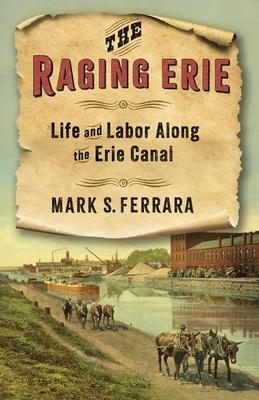The completion of the Erie Canal in 1825 was a monumental achievement. Linking the Great Lakes to the Atlantic Ocean, it transformed New York City into a hub of international trade, drove the rise of industrial cities in once sparsely populated areas, and accelerated the westward expansion of the United States. Yet few of the laborers who toiled along the canal shared in the prosperity it brought.
Mark S. Ferrara tells the stories of the ordinary people who lived, worked, and died along the banks of the canal, emphasizing the forgotten role of the poor and working class in this epochal transformation. The Raging Erie chronicles the fates of the Native Americans whose land was appropriated for the canal, the European immigrants who bored its route through the wilderness, and the orphan children who drove draft animals that pulled boats around the clock. Ferrara also shows how the canal served as a conduit for the movement of new ideas and religions, a corridor for enslaved people seeking freedom via the Underground Railroad, and a spur for social reform movements that emerged in response to the poverty and suffering along its path. Brimming with vivid characters drawn from the underbelly of antebellum life, The Raging Erie explores the social dislocation and untold hardships at the heart of a major engineering feat, shedding light on the lives of the canallers who toiled on behalf of American expansion.
The completion of the Erie Canal in 1825 was a monumental achievement. Linking the Great Lakes to the Atlantic Ocean, it transformed New York City into a hub of international trade, drove the rise of industrial cities in once sparsely populated areas, and accelerated the westward expansion of the United States. Yet few of the laborers who toiled along the canal shared in the prosperity it brought.
Mark S. Ferrara tells the stories of the ordinary people who lived, worked, and died along the banks of the canal, emphasizing the forgotten role of the poor and working class in this epochal transformation. The Raging Erie chronicles the fates of the Native Americans whose land was appropriated for the canal, the European immigrants who bored its route through the wilderness, and the orphan children who drove draft animals that pulled boats around the clock. Ferrara also shows how the canal served as a conduit for the movement of new ideas and religions, a corridor for enslaved people seeking freedom via the Underground Railroad, and a spur for social reform movements that emerged in response to the poverty and suffering along its path. Brimming with vivid characters drawn from the underbelly of antebellum life, The Raging Erie explores the social dislocation and untold hardships at the heart of a major engineering feat, shedding light on the lives of the canallers who toiled on behalf of American expansion.Paperback
$26.67